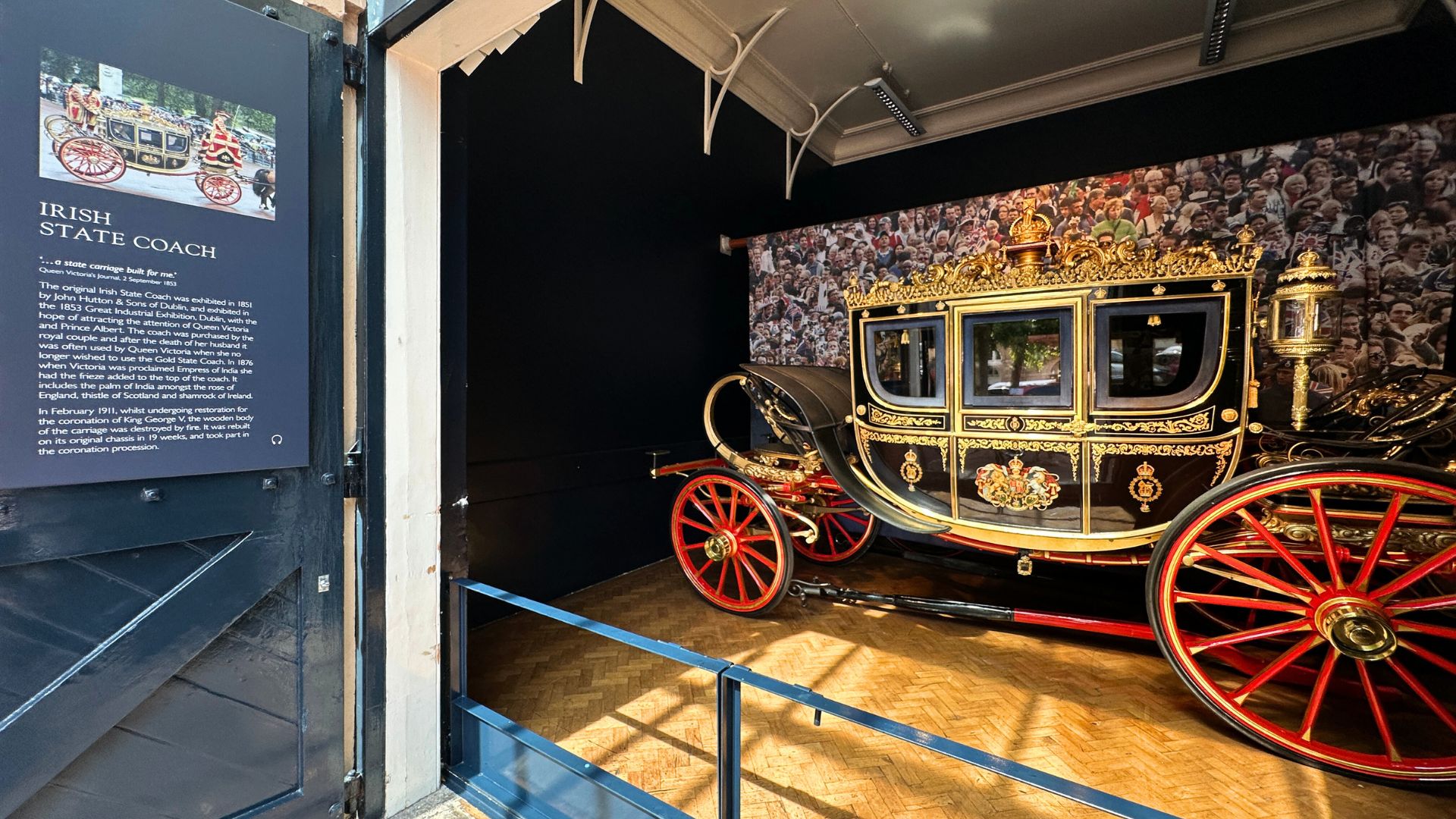The Royal Mews is a hidden gem in Buckingham Palace’s collection of royal sites. As a working part of the Royal Household for more than 200 years, the Royal Mews provides all horse-drawn and motor transport for the Monarch and the Royal Family, as well as being a residence for those that work at the Mews and Buckingham Palace.
Unassuming from the outside, entering this small courtyard feels like sneaking behind the curtain of royal life. As though you’ve discovered a secret door into the world of the monarchy, with plenty of unexpected treasures waiting inside.
Heading to the ticket entry, you’ll find airport-style security, like other historic sites such as Windsor Castle but on a smaller scale – knowing this, I pack light to move through quickly.

After meeting the friendly staff, I'm introduced to some of the attraction’s most popular residents – the Royal Mews horses. Shamus and Harry are two Cleveland Bay horses, towering in stature with big eyes and rich shining brown coats. Watching them squabble in their stables like brothers reminded me that even in the most serious roles, there’s always a playful side. There are around 30 horses that work at the Royal Mews, many of which were named by the late Queen – a tradition now carried on by King Charles III. A lovely touch of continuity, and the monarchy in miniature.
Continuing through the Mews and stepping into the quadrangle – made up of stables, tack rooms, offices, coach houses and private staff accommodation – you immediately sense the scale of operations in this living, working community of several generations. The late Queen Elizabeth II once described the site as a small village beside the palace. The towering skyscrapers beyond its walls make an interesting backdrop, a juxtaposition of old and new that so perfectly defines London.
A Royal working village for 200 years

Visiting during its 200th anniversary year, the site would have been a far cry from the flowerbed-lined balconies and four-wheel drives that stand here today. I pictured the noise of the horses – from loud neighs to click-clack of hooves cobbles - the smells drifting in from outside the walls and the bustle of bodies.

The name “Mews” originates from the royal hawks once housed at The King’s Mews in Charing Cross. After a fire destroyed the hawk house in 1534, it was rebuilt as stables but retained the name “Mews,” even though its function had changed. In 1825, the stables were relocated from Charing Cross to Buckingham Palace, where the Royal Mews has since served many purposes. Queen Victoria once visited to watch early photographs known as daguerreotypes being created—including an image of her son Prince Albert’s childhood pony. During the First World War in 1916, King George V and Queen Mary hosted a tea party here for wounded soldiers.
The coaches: from crown jewels to Royal weddings

Following the guided path, the next impressive features you encounter early on are the State Coaches. Regularly used for the five or so state processions throughout the year, each carriage has its own purpose, but the final decision on which one to use lies with The King. Much like matching a bag to an outfit, here it’s the carriage to the celebration.
Open stable doors allow a close-up view of the intricate details on the coaches, some more than a hundred years old. The decor is befitting of their purpose or reveals the origins of the coach itself – where it came from and who made it.
Each carriage is spotlighted in the audio guide, complete with visuals of the interior and unexpected stories from its many years in service. Although plush from the outside, they’re known to be rather uncomfortable and bumpy for those seated inside!

Highlights include Queen Alexandra’s State Coach (formerly the Irish State Coach), which carries the Crown Jewels from the Tower of London to Parliament for the State Opening. I particularly enjoyed the miniature crowns sitting upon small golden cushions, alongside a floral motif featuring the flowers of the nations of the UK and palm trees symbolising Queen Victoria’s reign as Empress of India – a homage to the connection between countries.
The Diamond Jubilee State Coach has a surprising origin, with its wood taken from HMS Victory, blending tradition with modern technology. Another favourite was the Glass Coach, a wedding carriage with no handles, making the footmen ever more essential – famously used by both a young Queen Elizabeth and Princess Diana. I couldn’t help but imagine a nervous footman fumbling with the doors and an anxious bride stuck inside.
Royal cars: vehicles of the Royal Mews
From the old to the new, it’s not just carriages at the Royal Mews – there’s plenty here for motor enthusiasts too. Six state limousines were introduced after the death of Queen Victoria, who had forbidden cars in the Mews during her lifetime. It was her son, King Edward VII who purchased the first ever motor car, starting a new collection. Today, the Royal Mews cars are an essential part of royal travel – with a few technical upgrades added along the way, of course.
The glamour is striking and unexpectedly cinematic compared with the heritage coaches. I found myself thinking of a high-speed chase in a Bond film, or the many iconic car scenes in The Princess Diaries. Each state car also features a unique mascot fixed to the bonnet, marking its official status. Much like the uniforms on display inside, every detail carries its own significance.
The Harness Room: 200 years of craft and care

A different kind of horsepower takes centre stage in the working Harness Room, a showcase of craftsmanship and dedication. Just as the transport must look its best, so too must the horses that pull the carriages. Some harnesses displayed here are as old as the Mews itself, and with more than 120 types in use, repairs and remakes are a constant task. The team’s skill has earned multiple awards at the annual Saddlers’ competitions.
The space, painted in the same peach shade as the exterior courtyards and hung with long lanterns, instantly transports you back in time. I could imagine people working by candlelight 200 years ago, tending to horses late into the night. Around the room, nostalgic carriages add extra colour – from a Santa’s sled to the official post cart. It’s also interactive: children can try their hand at harnessing a horse using a wooden statue, or compare their height measured in “hands” – a system introduced by Henry VIII.
The finale: The Gold State Coach
The final stop of the tour is impossible to miss: the mesmerising Gold State Coach. Housed in a vast room of its own, it feels almost theatrical with the curtains (in this case, stable doors) pulled back for a climactic reveal.

Hard not to be a favourite, this seven-metre-long carriage has played a starring role in coronations and jubilees for centuries. Archival footage plays on screens nearby, bringing to life moments where the coach carried Monarchs through cheering crowds.
Much like all things you see on television, the reality is both smaller and more precious in person. Leaning in, I couldn’t help but admire the fragility of something so iconic. At the same time, its sheer size and glimmering gold presence is impactful. A dazzling sight and one that is particularly striking, and perhaps necessary, against the backdrop of London on one of its greyer days.
Final thoughts
The Royal Mews tour is a hidden gem at Buckingham Palace, offering a rare glimpse behind the pageantry and the working community that makes it all possible. It’s not just about the carriages and state cars – it’s about the people, traditions and quiet pride that sustain them. I left feeling reflective about royal traditions, and about the many people who keep them alive, often unnoticed.
Families will enjoy the interactive elements and child-friendly audioguide, while royal enthusiasts can linger over historic coaches and living artefacts. At just over an hour, the tour is a must-see addition to a Buckingham Palace visit, and with free guided tours on the hour you’ll uncover plenty of hidden stories. Don’t forget to stop by the Royal Mews shop for exclusive souvenirs to remember your visit.
Two hundred years on, the Mews still blends living history with tradition. Visit during this anniversary year, or combine it with a trip to two other fantastic royal attractions - Buckingham Palace and The King’s Gallery - for the ultimate royal day out.
Book your tickets now to visit the Royal Mews at Buckingham Palace.

